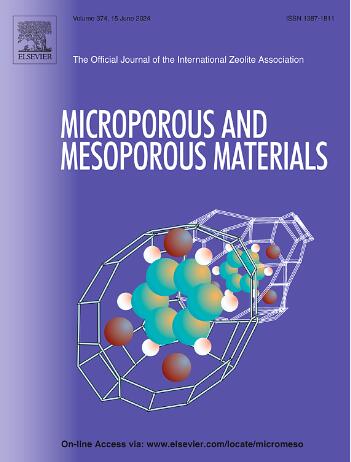Kinetic adsorption mechanism of cobalt(II) ions and Congo red on pristine and Schiff base-surface-modified MIL-101(Fe)-NH2
IF 4.8
3区 材料科学
Q1 CHEMISTRY, APPLIED
引用次数: 0
Abstract
This study investigates the adsorption kinetics of heavy metal ions (Co(II)) and azo dye (Congo red) using surface-modified MIL-101(Fe)-NH2. The material's large surface area and dual pore structure enhance adsorption performance, making it suitable for environmental applications. The MIL-101(Fe)-NH2 material was synthesized and further modified with 2-pyridinecarboxaldehyde to create MIL-101(Fe)-Pyr with the aim of enhancing the adsorption properties. Characterization techniques, including FTIR, TG/DTA, ss-NMR, XPS, N2 adsorption/desorption measurements, and PXRD, confirmed the structural integrity and functionalization of the materials. Kinetic studies revealed that MIL-101(Fe)-Pyr demonstrated superior adsorption capacity and faster kinetics for Co(II) ions compared to pristine MIL-101(Fe)-NH2. The adsorption mechanisms were analyzed using pseudo-first-order, pseudo-second-order, and Elovich models. The pseudo-second-order model provided the best fit for both Co(II) and Congo red adsorption. Boyd's diffusion model indicated that external diffusion is a significant rate-controlling step. The adsorption isotherms were fitted with the Freudlich and Langmuir models, and the thermodynamics of the adsorption processes were also studied. The adsorption mechanism of the selected pollutants was proposed, and the stability and reusability of the materials were investigated. The study concludes that surface modifications enhance the material's adsorption properties, making MIL-101(Fe)-Pyr a promising adsorbent for removing pollutants from aqueous environments.

求助全文
约1分钟内获得全文
求助全文
来源期刊

Microporous and Mesoporous Materials
化学-材料科学:综合
CiteScore
10.70
自引率
5.80%
发文量
649
审稿时长
26 days
期刊介绍:
Microporous and Mesoporous Materials covers novel and significant aspects of porous solids classified as either microporous (pore size up to 2 nm) or mesoporous (pore size 2 to 50 nm). The porosity should have a specific impact on the material properties or application. Typical examples are zeolites and zeolite-like materials, pillared materials, clathrasils and clathrates, carbon molecular sieves, ordered mesoporous materials, organic/inorganic porous hybrid materials, or porous metal oxides. Both natural and synthetic porous materials are within the scope of the journal.
Topics which are particularly of interest include:
All aspects of natural microporous and mesoporous solids
The synthesis of crystalline or amorphous porous materials
The physico-chemical characterization of microporous and mesoporous solids, especially spectroscopic and microscopic
The modification of microporous and mesoporous solids, for example by ion exchange or solid-state reactions
All topics related to diffusion of mobile species in the pores of microporous and mesoporous materials
Adsorption (and other separation techniques) using microporous or mesoporous adsorbents
Catalysis by microporous and mesoporous materials
Host/guest interactions
Theoretical chemistry and modelling of host/guest interactions
All topics related to the application of microporous and mesoporous materials in industrial catalysis, separation technology, environmental protection, electrochemistry, membranes, sensors, optical devices, etc.
 求助内容:
求助内容: 应助结果提醒方式:
应助结果提醒方式:


